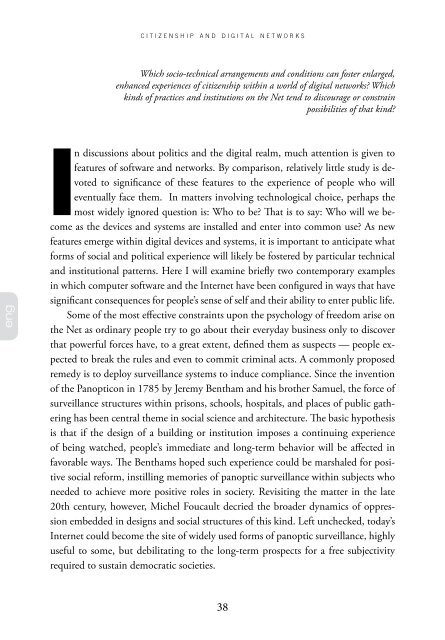Sergio Amadeu da Silveira - Cidadania e Redes Digitais
Sergio Amadeu da Silveira - Cidadania e Redes Digitais
Sergio Amadeu da Silveira - Cidadania e Redes Digitais
You also want an ePaper? Increase the reach of your titles
YUMPU automatically turns print PDFs into web optimized ePapers that Google loves.
eng<br />
c i t i z e n s h i p a n d d i g i t a l n e t w o r k s<br />
Which socio-technical arrangements and conditions can foster enlarged,<br />
enhanced experiences of citizenship within a world of digital networks? Which<br />
kinds of practices and institutions on the Net tend to discourage or constrain<br />
possibilities of that kind?<br />
In discussions about politics and the digital realm, much attention is given to<br />
features of software and networks. By comparison, relatively little study is devoted<br />
to significance of these features to the experience of people who will<br />
eventually face them. In matters involving technological choice, perhaps the<br />
most widely ignored question is: Who to be? That is to say: Who will we become<br />
as the devices and systems are installed and enter into common use? As new<br />
features emerge within digital devices and systems, it is important to anticipate what<br />
forms of social and political experience will likely be fostered by particular technical<br />
and institutional patterns. Here I will examine briefly two contemporary examples<br />
in which computer software and the Internet have been configured in ways that have<br />
significant consequences for people’s sense of self and their ability to enter public life.<br />
Some of the most effective constraints upon the psychology of freedom arise on<br />
the Net as ordinary people try to go about their every<strong>da</strong>y business only to discover<br />
that powerful forces have, to a great extent, defined them as suspects — people expected<br />
to break the rules and even to commit criminal acts. A commonly proposed<br />
remedy is to deploy surveillance systems to induce compliance. Since the invention<br />
of the Panopticon in 1785 by Jeremy Bentham and his brother Samuel, the force of<br />
surveillance structures within prisons, schools, hospitals, and places of public gathering<br />
has been central theme in social science and architecture. The basic hypothesis<br />
is that if the design of a building or institution imposes a continuing experience<br />
of being watched, people’s immediate and long-term behavior will be affected in<br />
favorable ways. The Benthams hoped such experience could be marshaled for positive<br />
social reform, instilling memories of panoptic surveillance within subjects who<br />
needed to achieve more positive roles in society. Revisiting the matter in the late<br />
20th century, however, Michel Foucault decried the broader dynamics of oppression<br />
embedded in designs and social structures of this kind. Left unchecked, to<strong>da</strong>y’s<br />
Internet could become the site of widely used forms of panoptic surveillance, highly<br />
useful to some, but debilitating to the long-term prospects for a free subjectivity<br />
required to sustain democratic societies.<br />
38


